Create a vibrant pesto without pine nuts that will enhance most any recipe. It’s rich and savory with a light tartness of bright lemon. The fresh taste of herbs enlivens salads, pastas, veggies and so much more. This recipe is keto-friendly and low-FODMAP with Whole30, paleo and AIP variations. It’s a versatile, budget-friendly recipe you will love!

Jump to:
- Why you’ll love this recipe
- What is pesto?
- Ingredients
- What is the best basil for pesto?
- Health benefits of basil
- What are pine nuts?
- Can you make basil pesto without nuts?
- Substitutes for pine nuts
- Is pesto keto?
- Is pesto low-FODMAP?
- Instructions
- Expert tips
- Making Paleo, Whole30 and AIP Pesto
- How to use
- How to store
- Can you freeze pesto?
- Variations
- FAQ
- Other recipes to use pine nut-free pesto
- 📖 Recipe
- 💬 Comments
Fresh homemade pesto is so much better than pesto you buy in a jar from the store. In just a few steps, you can have a fresh batch that elevates any meal. It mixes easily into Tuna Pesto Pasta and is phenomenal used on Homemade Keto Pizza or Avocado Toast.
Why you’ll love this recipe
- Fresh and flavorful – fresh, homemade pesto is more flavorful than store-bought. There’s really no comparison – it’s fresh and vibrant and just so good.
- So easy to make – with the help of your food processor or blender, it’s one of the easiest recipes to make
- Customizable – you can adjust ingredients for your taste
- It's a kitchen staple – make a big batch and freeze for easy use
- So versatile – it’s one of the most versatile ingredients in your kitchen
- Special diet friendly – this is FODMAP-friendly and low-carb keto with an easy Whole30 and paleo variation. It’s also simple to make an AIP pesto recipe.
What is pesto?
It’s a rustic, fragrant sauce that originates from Genoa, Italy. The word pesto comes from the word “pestare”, which means “to crush”. A classic pesto recipe included basil, pine nuts, olive oil, parmesan and garlic, combined and crushed in a mortar and pestle. While some may prefer using that method, a food processor or blender makes the job so much easier and takes far less effort.
Today, there are many variations of the classic recipe, with other healthy, less-expensive swaps for the pine nuts. Basil is also commonly replaced with other leafy greens such as kale or spinach.
Pesto sauce has many uses that go far beyond pasta and summer recipes. It pairs wonderfully with meats, poultry, fish, eggs and vegetables. It’s also wonderful to use in soups and salad dressings.
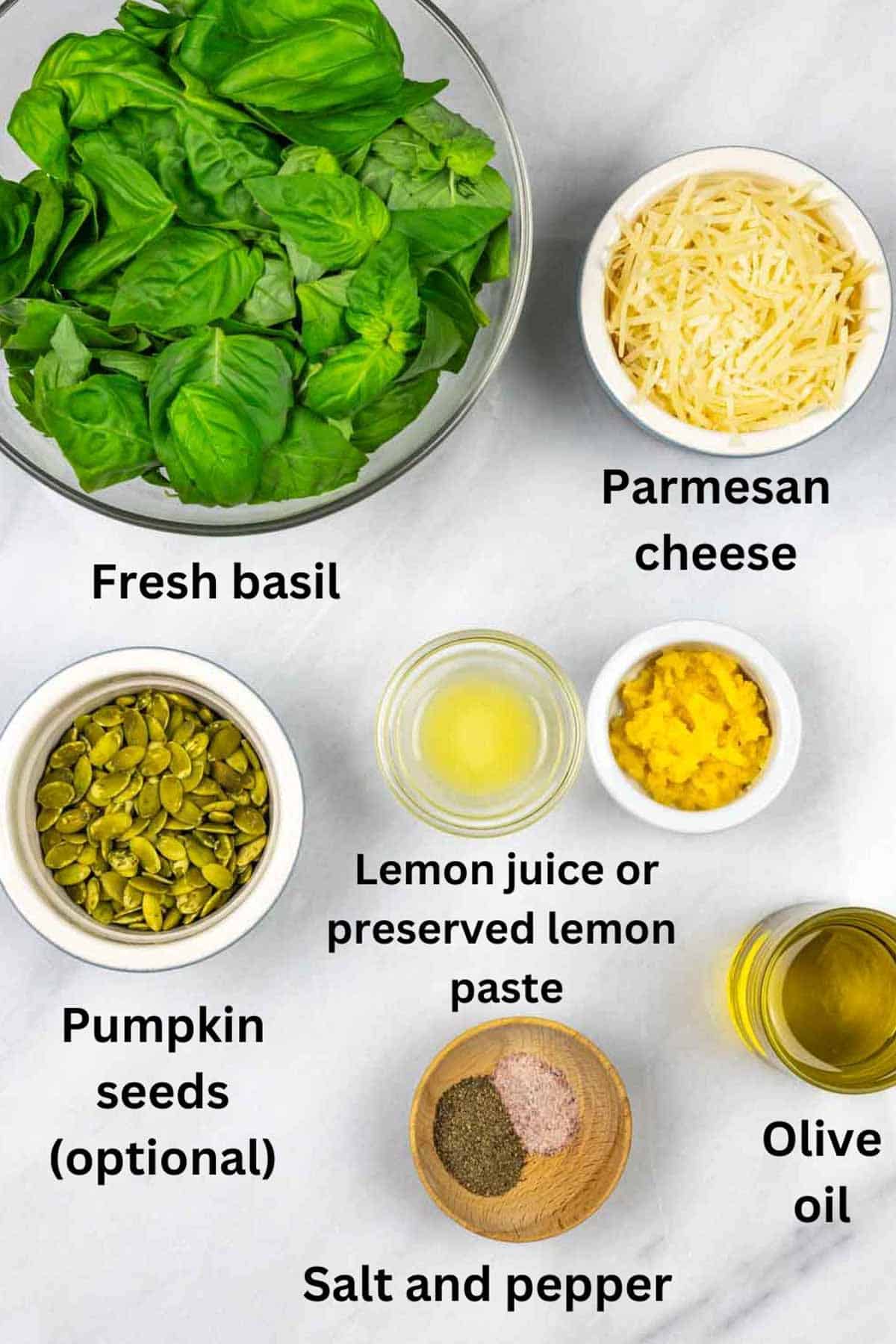
Ingredients
- Basil – fresh basil leaves are essential. Rinse and pat dry before using.
- Parmesan cheese – adds saltiness and texture. If you don’t have parmesan, use any hard Italian cheese or your favorite plant-based cheese. See below for paleo and Whole30 variations.
- Olive oil or other neutral oil – adds a rich, creamy consistency
- Lemon juice or preserved lemon puree – really brightens the flavor and enhances flavors of other ingredients. I highly recommend using preserved lemon puree. It lends an umami and more subtle lemon flavor that’s unmatched by fresh lemon juice. See my Preserved Lemon Puree Ingredient Spotlight to read more about this favorite ingredient and learn how to make your own.
- Nuts or seeds (optional) – add structure, texture and slight nutty flavor. I like to use pumpkin seeds.
- Salt – enhances the flavors of other ingredients. I love to use kala namak black salt. Read more about my favorite salt in this Kala Namak Ingredient Spotlight.
- Pepper – contributes mild spice, earthiness and brings other flavors together
For AIP: Since nuts and parmesan are not AIP compliant, I include a variation for the AIP protocol.
Traditional pesto: for a classic version, if you don’t follow a low-FODMAP diet, add fresh garlic.
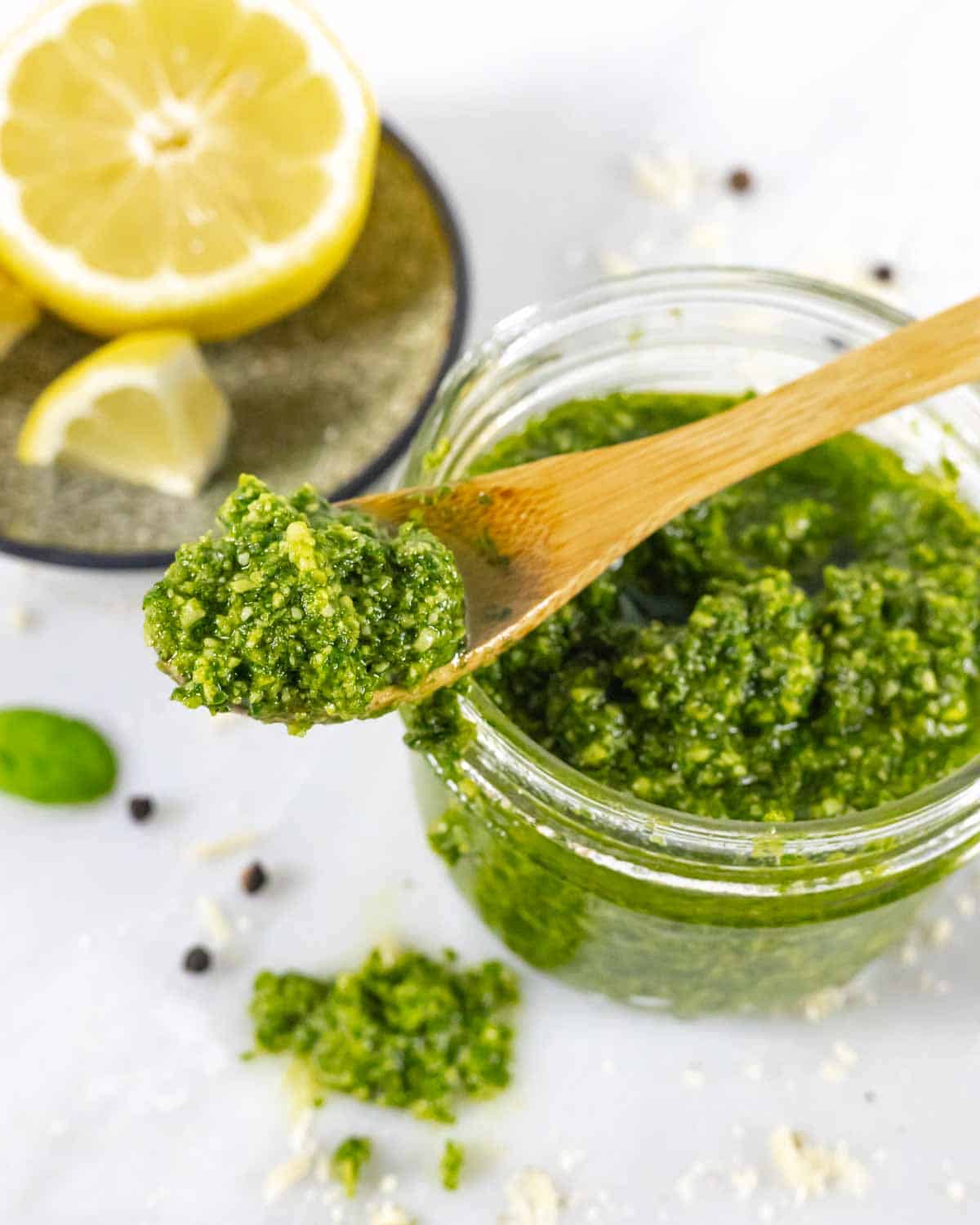
What is the best basil for pesto?
Fresh basil is the heart of this recipe and what makes it unique. Dried herbs can’t be used as a fresh basil substitute. However, the variety of basil you use is completely up to you.
There are many varieties of basil, each with a slightly different flavor profile.
- Genovese and sweet basil – are most commonly used in Italian recipes and readily available at most grocery stores
- Thai basil – is highly aromatic with citrus notes
- Purple basil – has a striking burgundy color and adds a hint of clove
- Lemon, cinnamon and lime basil – contribute unique flavors
Health benefits of basil
While basil is typically not consumed in large enough quantities to contribute significant vitamins and minerals, it is used medicinally in addition to its culinary uses. As a member of the mint family, it contains similar properties to mint and is often used for nausea and digestive upset.
It’s high in essential oils that are used as fragrance as well as medicinal uses such as lowering cholesterol and triglycerides and decreasing inflammation.
Basil contains many vitamins, minerals and antioxidants such as lutein, beta-carotene and zeaxanthin, that reduce oxidative stress by fighting free-radicals in the body.
What are pine nuts?
Pine nuts, also called pignoli, are the edible seeds of certain types of pine trees. They are typically expensive due to the time it takes to grow the nuts as well as the effort required to harvest them and remove them from their hard outer shell.
They are high in natural oils, have a buttery texture and have a mild, sweet flavor when mixed with other ingredients.
Can you make basil pesto without nuts?
Yes, absolutely. Pine or other nuts are not a necessary ingredient and can be eliminated altogether. However, they do provide a bit of structure to the sauce.
In place of nuts, seeds can add a similar nutty texture and can be a very tasty addition. I love to use pumpkin seeds for their high omega-3 content and nutty flavor.
Substitutes for pine nuts
Many nuts and seeds can be used as a pine nut alternative and are an economical substitute for pine nuts in pesto.
Keto and FODMAP-friendly seeds include: pumpkin seeds (pepitas), sunflower seeds and hemp hearts.
Low-carb and low-FODMAP nuts include: walnuts, pecans, Brazil nuts and almonds.
Keep in mind, cashews and pistachios are not low-FODMAP nuts and are also higher in carbs than other nut options. However, they are delicious pine nut alternatives and lend a savory, buttery flavor to the sauce.
I don’t recommend using flax or chia seeds because they absorb moisture, making this recipe too thick. They also will create a slightly slimy texture, which you want to avoid.
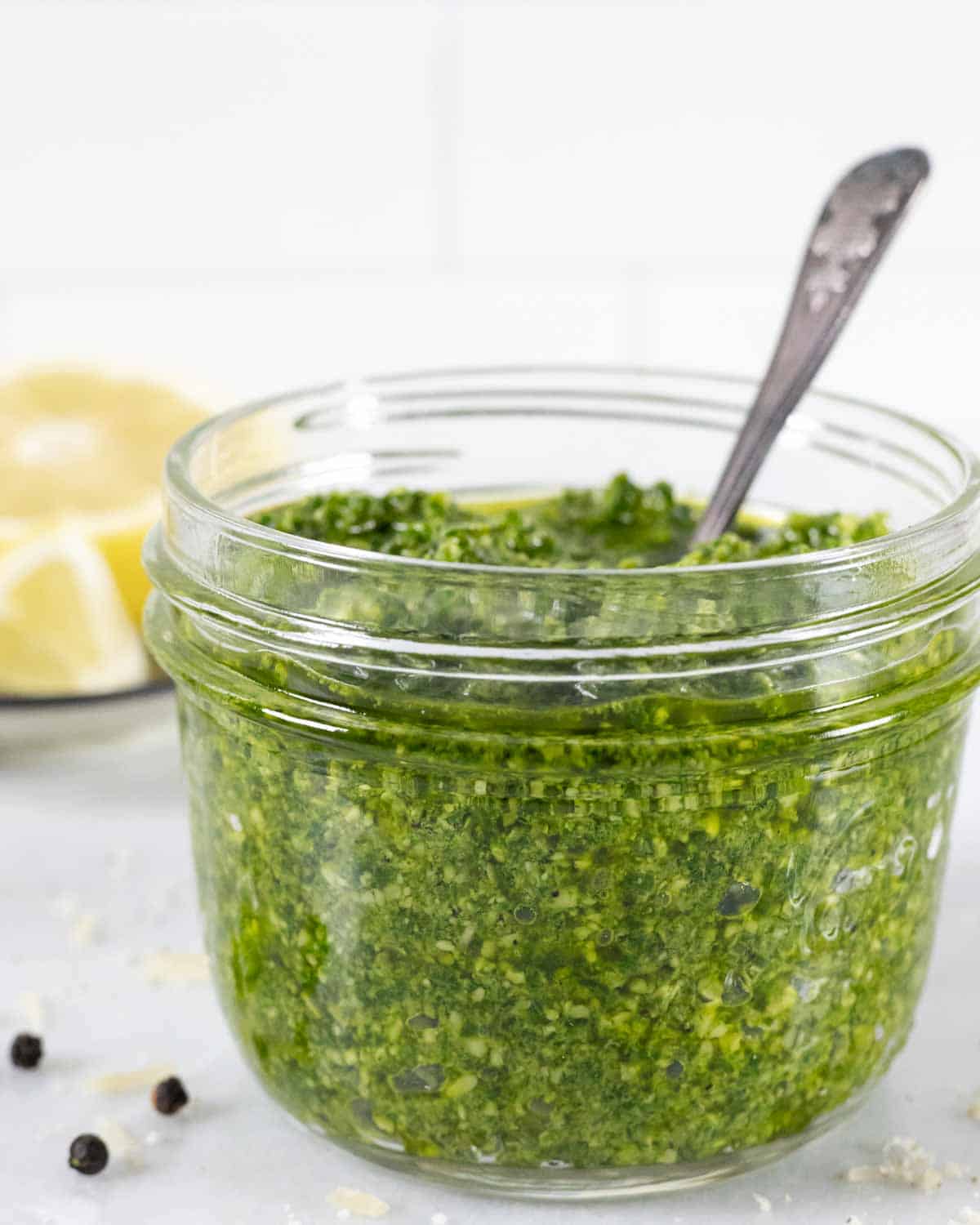
Is pesto keto?
Most recipes are keto-friendly. All of the ingredients have very little to no carbohydrates, making it a perfect keto condiment and ingredient to keep on hand. See my Keto Diet Resources for more information about a keto lifestyle.
Is pesto low-FODMAP?
This is absolutely a low-FODMAP pesto. Basil is a tasty low-FODMAP seasoning and parmesan contains no lactose, making it a low-FODMAP cheese. Oils are fats and do not contain sugars, making olive oil low-FODMAP in any serving size.
Many recipes and store-bought varieties contain garlic and/or onions or other FODMAPs. Read ingredient labels and purchase from a trusted source to avoid potential digestive upset. Better yet, make your own! This is a superb no garlic no onion recipe to keep on hand. You can find more low-FODMAP mains, sauces, seasonings, condiments and more by visiting my Low-FODMAP Recipes.
Instructions
This homemade recipe comes together in just minutes using a food processor or blender.
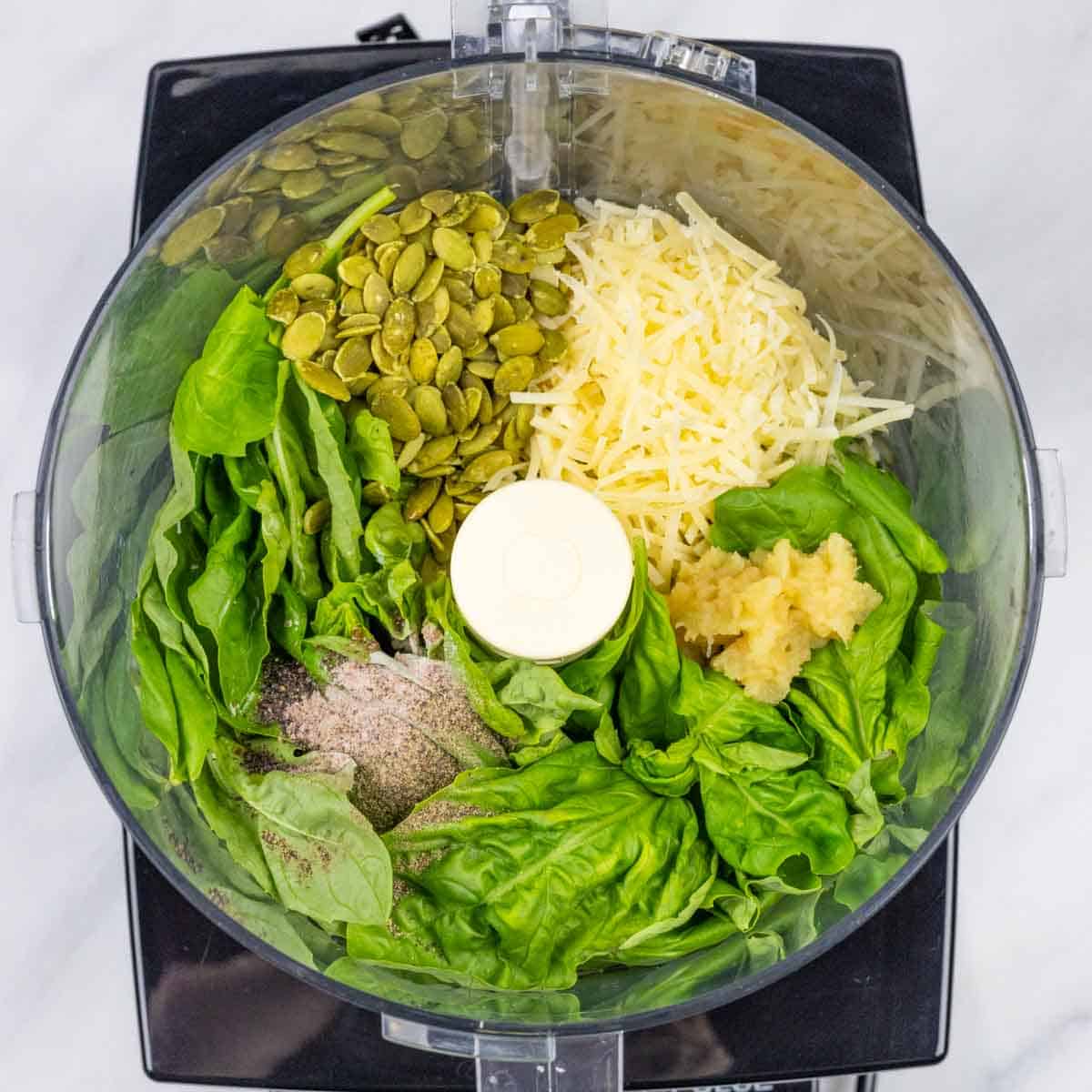
- Add the basil, cheese, nuts or seeds (if using), lemon juice, salt and pepper to your food processor or blender
- Pulse until finely chopped
- Scrape down the sides and add the olive oil
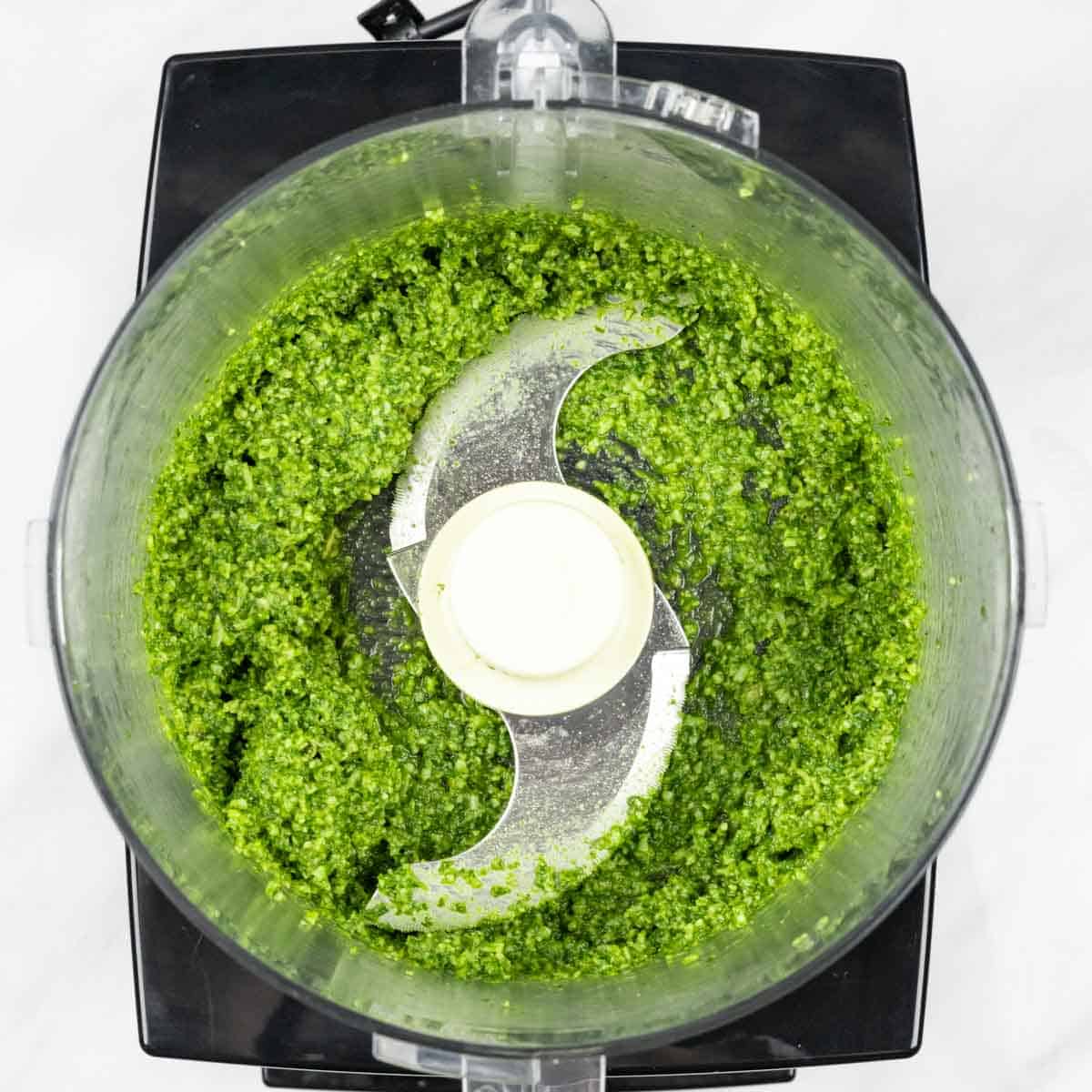
- Pulse until everything is blended together and smooth in consistency
- Season to taste. If adding additional seasonings, pulse one or two more times.
Expert tips
- If using an oil other than olive oil, feel free to add it at the beginning, when combining the other ingredients in the food processor or blender. Olive oil can develop a slightly bitter taste when blended too much, so it’s always best to add it at the end to ensure minimal processing.
- For a thinner pesto, simply add more olive oil one tablespoon at a time. Be conservative when adding more oil because a little goes a long way. You can add more if you need to, but you can’t remove it once you’ve poured it.
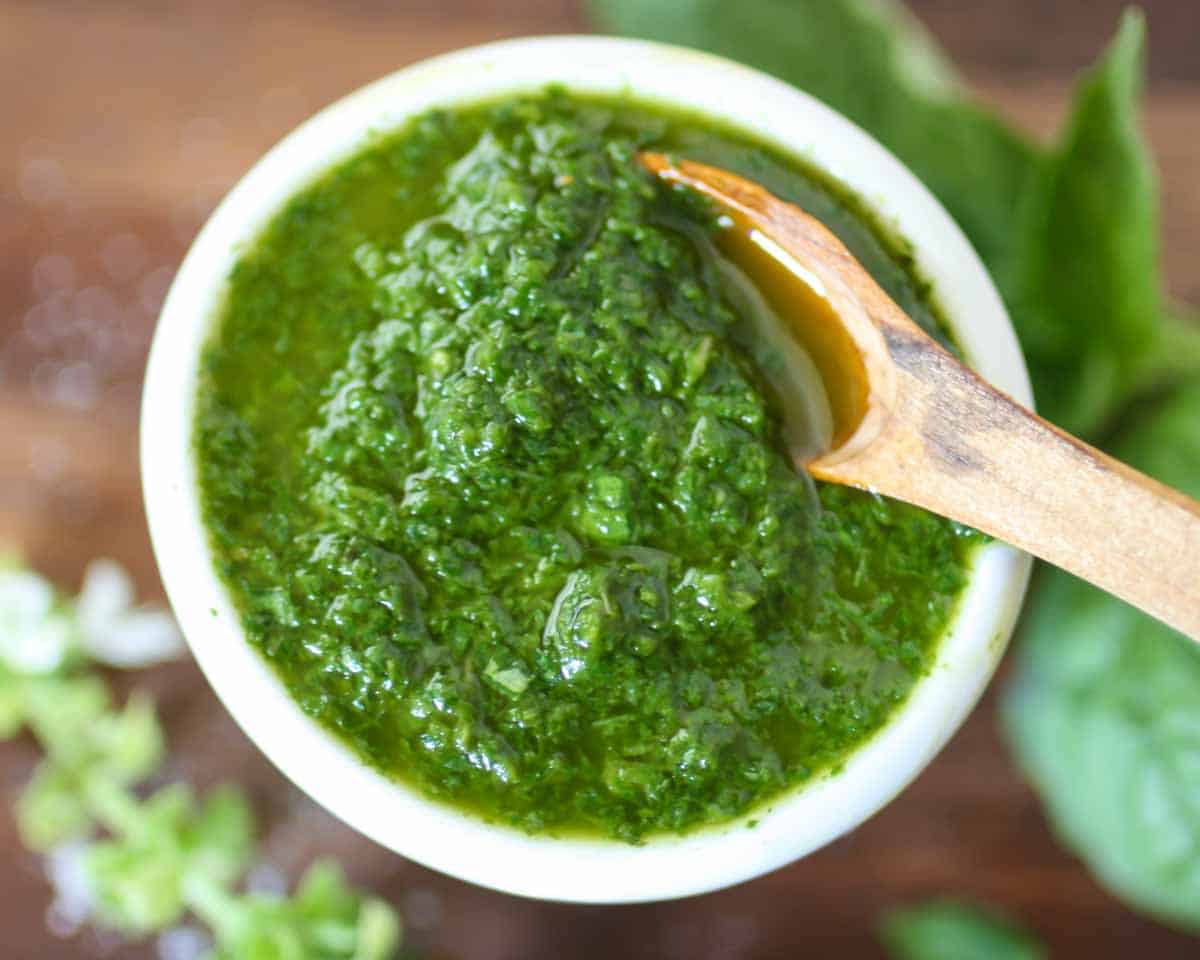
Making Paleo, Whole30 and AIP Pesto
Make a bold, fresh, nut-free and/or dairy-free pesto that’s a great addition to so many recipes. It’s also a perfect vegan pesto option, as well.
For an AIP pesto, simply eliminate the parmesan, black pepper and any nuts or seeds in this recipe and blend the ingredients together in your food processor or blender.
If you want to make a paleo or Whole30 pesto recipe, simply eliminate the cheese or replace it with your favorite plant-based cheese.
To add a cheesy flavor without using cheese, add nutritional yeast as a parmesan cheese substitute. 1-2 tablespoons should be plenty, but start small and always season to your tastes.
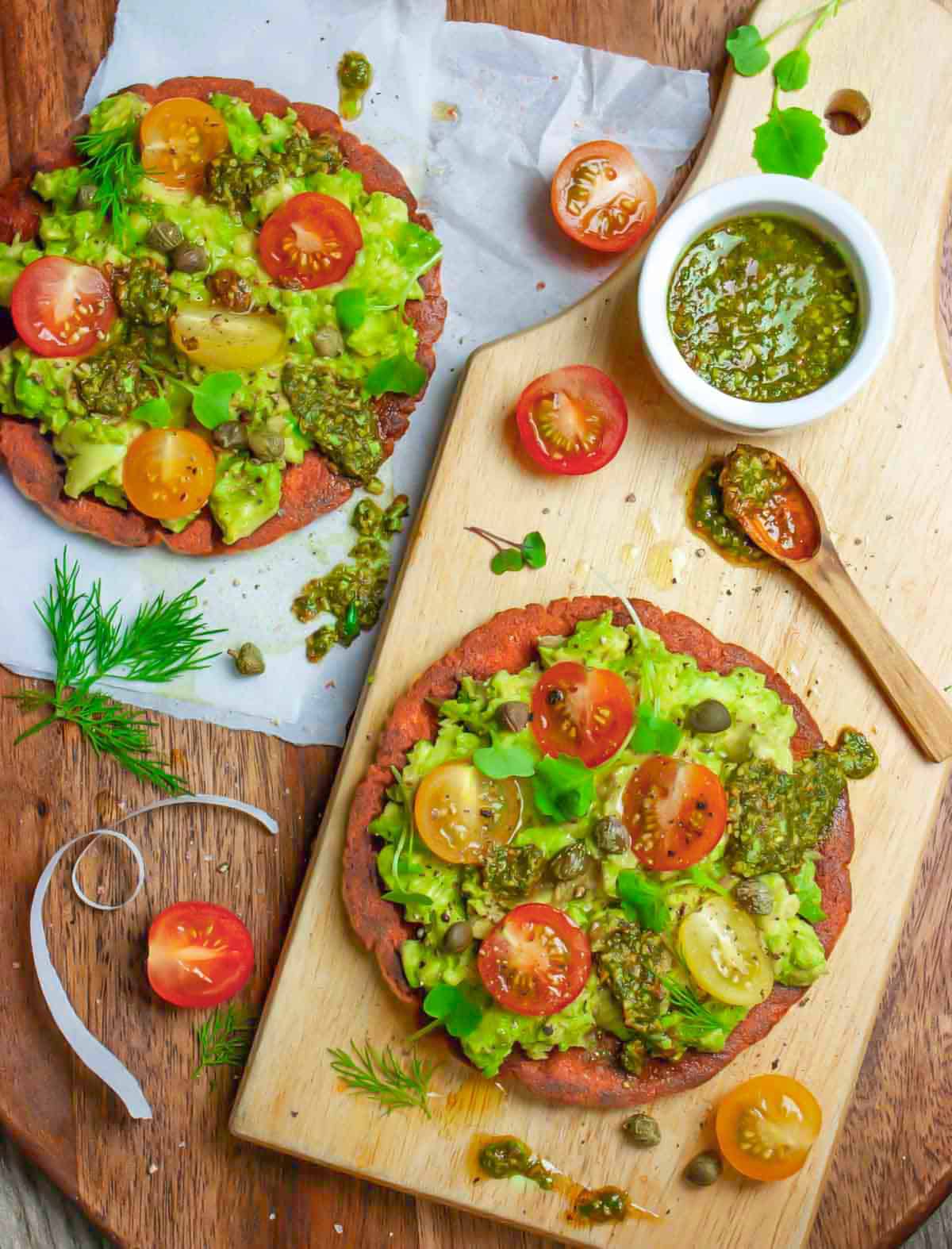
How to use
There are so many ways to use your healthy keto pesto recipe - here are just a few:
- Swirl it in – stir into your favorite soup
- Pizza base – replace tomato sauce for a perfect homemade pizza
- Top your favorite protein – use as a topping for fish, chicken or veggies before cooking
- Mix with eggs – use in omelets or mix into scrambled eggs with ham for a fun green-eggs-and-ham St. Patrick’s Day breakfast. It’s healthy green food!
- Add to pasta or rice – toss with your favorite pasta as a tasty green pasta sauce or mix into cauliflower rice
- Make a spread – mix with mayonnaise and use as a spread on burgers or sandwiches using low-FODMAP Sandwich thins or delicious Parmesan Oregano Bread. Try making a pesto grilled cheese!
- Avocado toast – mash avocados, or make some homemade quacamole and create the best Avocado Toast for an extra special breakfast or lunch
- Dip – this makes a super low-FODMAP dip
- Make chicken or tuna pesto salad – simply mix in with your favorite canned tuna or chicken to top lettuce, make a wrap or quick sandwich
How to store
Store in an airtight container in the refrigerator for up to 5 days.
Can you freeze pesto?
Yes, it freezes very well. Freeze in airtight, freezer safe containers or in zip-top freezer bags.
The best way to freeze pesto is to scoop into small portions in an ice cube tray. When frozen, place the cubes in a freezer bag and store for up to 6 months. These thaw very quickly for use at room temperature. Also, add a frozen cube to soups or stews or when sauteeing veggies.
I love to make big batches and freeze it in small mason jars for holiday gifting.
Variations
- Use different seeds – use hemp or sunflower seeds in place of pumpkin seeds
- Add your favorite nut – Swap seeds out for your favorite nuts. See my substitutes for pine nuts for great options.
- Use a different herb or leafy green vegetable – cilantro, parsley, spinach, kale or even beet greens work well
- Try a different cheese – such as asiago, manchego or romano
- Elevate the flavor – add sun dried tomatoes, roasted red peppers, charred jalapeno or add in other seasonings such as red pepper flakes, Aleppo pepper or some nutritional yeast
- Add lemon zest – for a more pronounced lemon flavor
- Use different salts – smoked salt or truffle salt is amazing
- Try a different oil – garlic infused oil or truffle oil are tasty options
FAQ
A tablespoon of pesto contains under 1g net carbs, essentially making it carb-free.
Yes, pesto is very healthy. Olive oil contains ingredients that are part of a heart healthy Mediterranean diet, including omega-3 fatty acids. Other ingredients may reduce inflammation and risk of cancer, heart disease and diabetes.
Blanching basil creates a very vivid green color and may keep it from oxidizing and turning brown. It can be quickly blanched in boiling water for about 10 seconds, then plunged into ice water to stop the cooking. It can then be patted dry and used.
There are two main reasons why this could happen. The oil may be past it’s ‘best by’ date or has turned rancid. Or, it may have been blended for too long, developing a bitterness from over-blending.
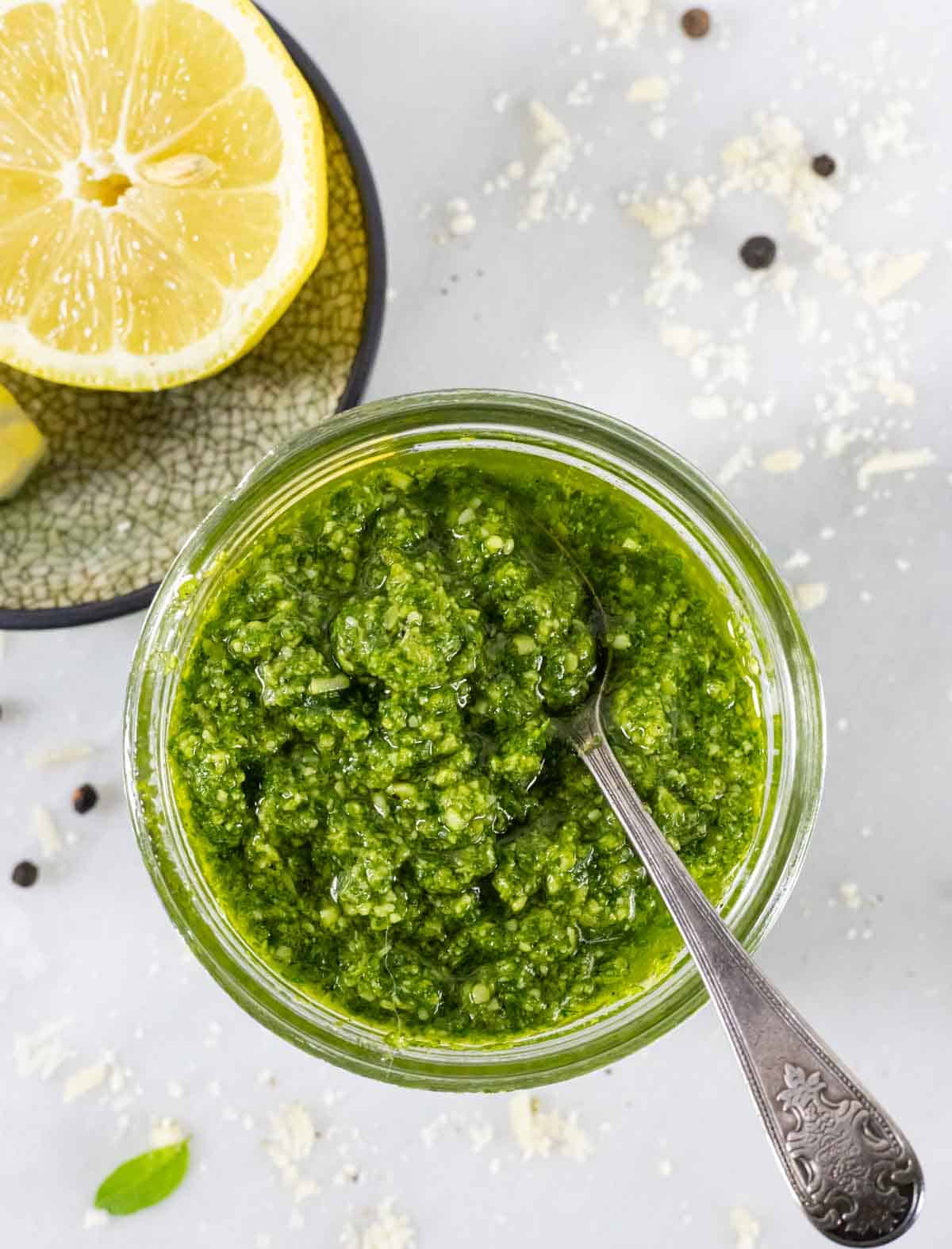
Did you make this recipe? Let me know how you liked it by giving a star rating and leaving a comment!
📖 Recipe
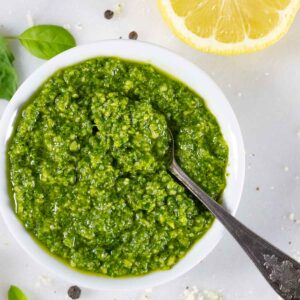
Pesto without Pine Nuts (FODMAP-friendly and low-carb)
Ingredients
- 2 cups fresh basil
- ½ cup parmesan cheese
- ¼ cup pumpkin seeds (optional. Or use nuts or seeds of choice - see Notes.)
- ½ cup olive oil (or other neutral oil)
- ½ teaspoon salt (I like to use kala namak black salt. See my Kala Namak Ingredient Spotlight.)
- ½ teaspoon black pepper
- 1 tablespoon lemon juice (or ½ teaspoon preserved lemon paste. Read more in my Preserved Lemon Paste Ingredient Spotlight.)
Instructions
- Add the basil, cheese, nuts or seeds (if using), lemon juice, salt and pepper to your food processor or blender.
- Pulse until finely chopped.
- Scrape down the sides and add the olive oil.
- Pulse until everything is blended together and smooth in consistency.
- Season to taste. If adding additional seasonings, pulse one or two more times.
Notes
Expert tips
- If using an oil other than olive oil, feel free to add it at the beginning, when combining the other ingredients in the food processor or blender. Olive oil can develop a slightly bitter taste when blended too much, so it’s always best to add it at the end to ensure minimal processing.
- For a thinner pesto, simply add more olive oil one tablespoon at a time. Be conservative when adding more oil because a little goes a long way. You can add more if you need to, but you can’t remove it once you’ve poured it.
See post for variations to make a paleo, Whole30 or AIP pesto.
Variations
- Use different seeds – use hemp or sunflower seeds in place of pumpkin seeds or swap seeds for your favorite nuts. See Substitutes for Pine Nuts.
- Different herbs or leafy green vegetables – cilantro, parsley, spinach, kale or beet greens
- Try a different cheese – such as asiago, manchego or romano
- Elevate the flavor – add sun dried tomatoes, roasted red peppers, charred jalapeno or add in other seasonings such as red pepper or Aleppo pepper flakes or some nutritional yeast
- Add lemon zest – for a more pronounced lemon flavor
- Use different salts – smoked salt or truffle salt is amazing
- Try a different oil – garlic infused oil or truffle oil are tasty options
How to use
- Swirl it in – stir into your favorite soup
- Pizza base – replace tomato sauce for a perfect homemade pizza
- Top your favorite protein – use as a topping for fish, chicken or veggies before cooking
- Mix with eggs – use in omelets or mix into scrambled eggs with ham for a fun green-eggs-and-ham St. Patrick’s Day breakfast. It’s healthy green food!
- Add to pasta or rice – toss with your favorite pasta or mix into cauliflower rice
- Make a spread – mix with mayonnaise and use as a spread on burgers, sandwiches and more. Try a making a pesto grilled cheese!
- Avocado toast – make some homemade guacamole and create the best Avocado Toast for an extra special breakfast or lunch
- Dip – this makes a super low-FODMAP dip
- Make chicken or tuna pesto salad – simply mix in with your favorite canned tuna or chicken to top lettuce, make a wrap or quick sandwich with Low Carb Sandwich Thins
Nutrition
*Net carbs = carbohydrates - fiber
Nutritional information is an estimate, calculated using online tools and does not include optional ingredients unless otherwise indicated.

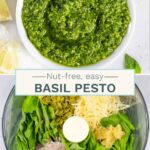
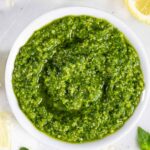
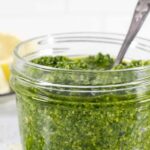
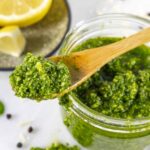

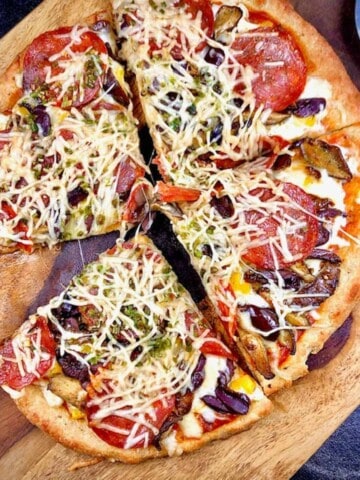



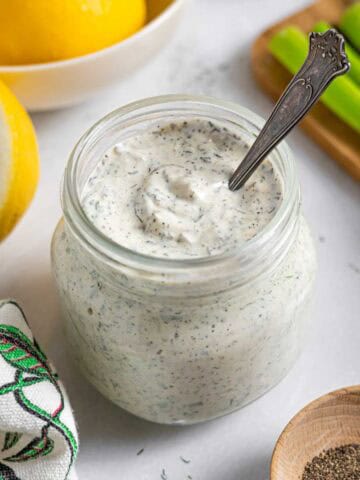
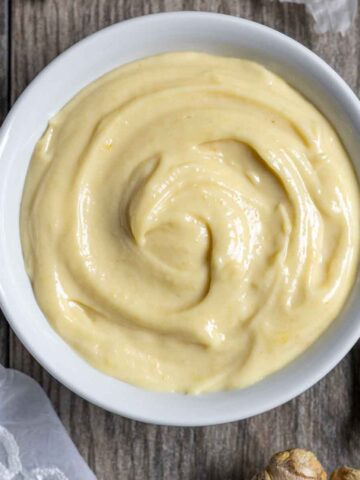

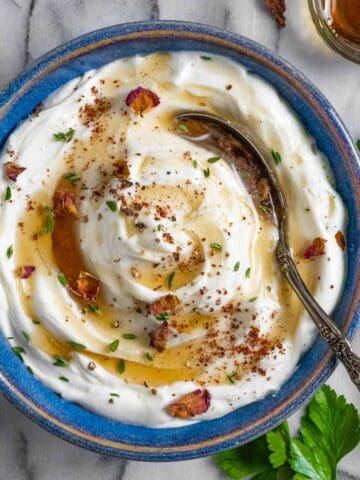
Tracey Hatch-Rizzi says
I always make a big batch and freeze my pesto in ice cube trays so it will thaw quickly. I can easily add a frozen cube to sautéed veggies or noodles.